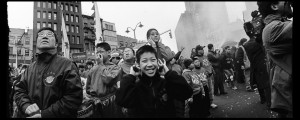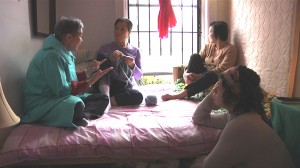
Chinatown Street celebration photo by Alan Chin
January 24 – January 26, 2014
ANTHOLOGY FILM ARCHIVES
Whether you see Chinatown as a place or a state of mind, a purgatory or an oasis, a shrinking immigrant community or an expanding business district, its presence in our cinematic imagination is enormous. Situated north of NYC’s Wall Street, east of the Tombs, west of the old Jewish Ghetto, and mostly south of Canal, the neighborhood that began in the mid-19th century has maintained its distinct character – savory, hardscrabble, succulent, and cacophonous.
WE LANDED/I WAS BORN/PASSING BY explores a provocative array of images of the community from the 1940s to the present day. By embracing the perspectives of grassroots activists, performance artists, conceptual visionaries, home-movie makers, punk horror devotees, and journalists, the series raises questions about how we look at the neighborhood and how its representations have reciprocally shaped our imagination. Who lived in Chinatown at the beginning? Who lives there now? How and why has it changed? What language best describes Chinatown? Whose voices do we hear?
Inspired by the fabulously observant 1960s poetry of Chinatown’s very own Frances Chung, this 5-part film series looks at the streets, desires, shops, and struggles of an iconic community that only begins to reveal its stories when the most obvious outer layers are pulled back. Comprised of documentaries, archival footage, home videos, literary readings, photography, and performance, the series rings in Chinese New Year by opening a window to both early and contemporary conditions. Through it all, geography, memory, and observation compress and expand the imaginary and the real of this beloved section of the Big Apple.
Curated by Lesley Yiping Qin, Lynne Sachs, Bo Wang, and Xin Zhou.
Anthology Film Archives | 32 Second Ave, New York, NY 10003 | (212) 505-5181
Fri, Jan 24 7:30pm | PROGRAM 1: TWO COLD NIGHTS IN NEW YORK CHINATOWN
1月24日(週五)晚7:30 | 影片集1:紐約華埠之兩個寒夜
Part of the Chinatown Film Project commissioned by the Museum of Chinese in America, Jem Cohen’s NIGHT SCENE IN NEW YORK is a close nocturnal observation of the people and lights of this urban milieu. In contrast to Cohen’s beautifully shot yet vernacular street scenes, conceptual artist Gordon Matta-Clark’s black-and-white video work expresses a more distant gaze on the Chinatown community, offering an ambivalent and imaginary take on the same cityscape. VOYEUR CHINATOWN (1971) Dir. Gordon Matta-Clark | NIGHT SCENE NEW YORK (2009) Dir. Jem Cohen | A reading Annie Ling from Crazy Melon and Chinese Apple: The Poems of Frances Chung.
Sat, Jan 25 6:00pm | PROGRAM 2: THE TOUCH OF AN EYE
1月25日(週六)晚6:00 | 影片集2:視線的觸覺
The view from above – the bird’s eye view – can be omniscient and detached, playful and wicked. Shelly Silver’s TOUCH, a restrained yet endlessly sensual ciné-essay on loss and presence, takes us on a journey that begins with the psyche of an enigmatic son who returns as both insider and outsider to a Chinatown from which he escaped. Celebrated 1960s community activist Tom Tam also shot irrepressibly inventive experimental films of the world he fought so hard to defend. Tam’s pixilated glimpse of a boy on a roof gives voice to a child’s sense of flight and the realization that he will never have wings. BOY ON CHINATOWN ROOF (1970s) Dir. Tom Tam | TOUCH (2013) Dir. Shelly Silver. Followed by a reception.
Sat, Jan 25 8:00pm | PROGRAM 3: CHINATOWN PROBLEMATICS
1月25日(週六)晚8:00 | 影片集3:華埠問題考
How can realities be engaged if the idea of a place has already been mediated by a sense of otherness and displacement? It all began with the name “Chinatown”, a specific place that can be found in many cities of the world. THE TROUBLE WITH CHINATOWN, originally aired on WNBC in the 1970s was a survey of social and educational problems. A 2013 CNN “exposé” on the “dirty, dangerous firetrap” at 81 Bowery Street sparked the eviction of the tenants who couldn’t afford another place to live. The reactions today can be linked to Tom Tam’s silent film TOURIST BUSES, GO HOME! that protests against Chinatown tourism. Shelly Silver’s 5 LESSONS AND 9 QUESTIONS ABOUT CHINATOWN interweaves fragments of neighborhood lives with questions of history, change, a sense of belonging and home. Followed by an informal talk by photographer Corky Lee, an activist in the Asian and Pacific American community for the past forty years. WNBC-TV THE TROUBLE WITH CHINATOWN (1970) Dir. Bill Turque | TOURIST BUSES, GO HOME! (1969) Dir. Tom Tam | 5 LESSONS & 9 QUESTIONS ABOUT CHINATOWN (2011) Dir. Shelly Silver | CNN report on 81 Bowery St: “Eviction & Protest” (2013) | Photos and artist talk by Corky Lee.
Sun, Jan 26 5:00pm | PROGRAM 4: BOWERY STREET PLAYBILL
1月26日(週日)晚5:00 | 影片集4:包厘街戲單
Quotidian life is provoked and embodied in this eclectic playbill of Chinatown. We begin with a quietly rueful look at the closing-down of MUSIC PALACE, the last Chinatown movie theater on Bowery Street. In contrast is MAKING CHINATOWN, a reenactment parody of Polanski’s CHINATOWN and its profiling LA Chinatown as a lawless enclave. From the upfront self-mocking of PAPER SON, to two lesbians munching fortune cookie messages in I AM STARVING, to following grocery shoppers home for dinner in THE TRAINED CHINESE TONGUE, everyday experiences constantly negotiate the personal. Interspersed are two historical documentations of Chinese New Years in the 40s and 60s. Chinatown-born photojournalist Alan Chin will provide his vision of the neighborhood through his candid, sharply rendered insider’s eye. MUSIC PALACE (2005) Dir. Eric Lin| MAKING CHINATOWN Pt. 7 (2012) by Ming Wong | I AM STARVING (1998) Dir. Yau Ching | THE TRAINED CHINESE TONGUE (1994) Dir. Laurie Wen | YEAR OF THE RAT (1963) Dir. Jon Wing Lum | Photo slideshow by Alan Chin.
Sun, Jan 26 7:30pm | PROGRAM 5: A TIME OF TWO SQUARE MILES
1月26日(周日)晚7:30 | 影片集5:方圆二英里的時光
Mixing live readings and videos, this program investigates domestic and public spaces in the two square miles of Chinatown. Shanghai-born performance artist Jiaxin Miao carries his suitcase between Chinatown and Zuccotti Park and then boldly sprays colors onto roast ducks. Galvanized by flickering and fast forward motions, revered political activist Tom Tam’s intimate camera work captures the communal life of a health fair in Columbus Park. Lynne Sachs’ hybrid documentary is set in shift-bed rooms in Chinatown where performers transform their everyday movements into dance and are tenderly challenged to leave their shared, self-supporting world. After traveling ten thousand miles to get here, what is it like to go five miles further? Followed by readings of work by novelist Ha Jin and poet Frances Chung, who belong to two different generations of Chinese-American writers. A reading by Herb Tam from a novel Ha Jin | CHINATOWN STREET FESTIVAL (1970s) Dir. Tom Tam | CHINAMAN’S SUITCASE (2011) Featuring Jiaxin Miao | YOUR DAY IS MY NIGHT (2013) Dir. Lynne Sachs | A reading by Paolo Javier of poetry by Frances Chung.



